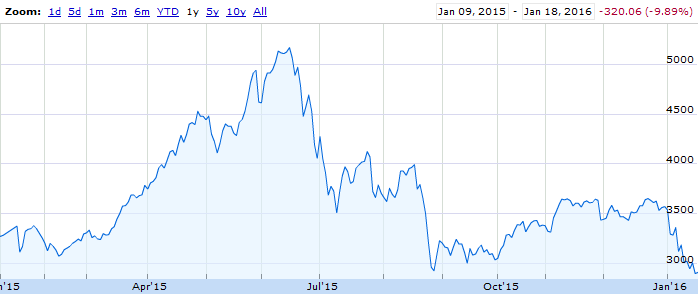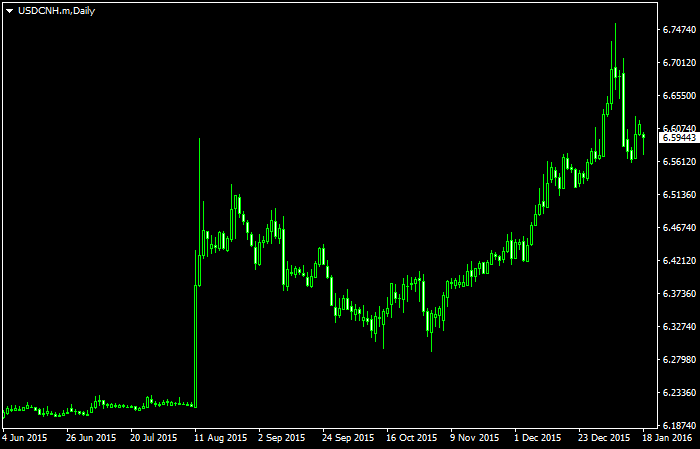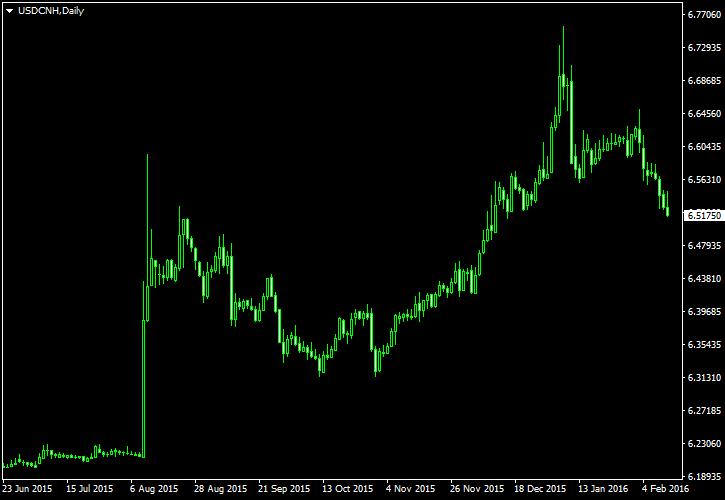
What all this fuss regarding China, Shanghai stock market index, and the Chinese yuan is really about? Is it something that Forex traders should watch or is it just some fad hyped by media as a convenient hot topic? The thing is, the ongoing crisis in China is likely a major global economic factor that will affect not just USD/CNY rate but the whole world’s economy and with it the Forex market in general.
Background
Contents
- 1 Background
-
2 Timeline
- 2.1 2014
- 2.2 2015
- 2.3 2016
-
3 Future scenarios
- 3.1 Strong recovery to pre-crisis growth rates
- 3.2 Continued decline of economic growth rate
- 3.3 Crisis stagnation
- 4 Keep an eye on news and charts
- 5 Poll
After three decades of astonishing economic growth, the Chinese economy showed signs (brief stock market bubble) of overheating in 2007. When China raised the interest rates in an effort to cool the economy in mid-2011, the first evidence of the blooming economic crisis appeared in the form of a wave of loan defaults from entrepreneurs.
Between 2012 and 2014, the country experienced a decline in lending, a fall in the profitability of companies (including PetroChina), decrease in the consumer price index, softening of foreign investments and a decline in the exports. Although the latter declines were small, it did point out the vulnerability of country, which is heavily reliant on foreign investments and exports to drive growth. The implications of a stronger yuan and the stumbling global economy were clear. The Chinese regime did all that is required to rejuvenate the system. However, the country lacked one important pillar of a strong economy, i.e. domestic spending that contributes to the national growth. This ultimately led to the current economic crisis as shown by the timeline of events.
Timeline
2014
January 1
In an effort to slowly reform the economy and keep up with the promise made to the international community, China allowed gradual appreciation of the yuan, which is under managed float. From a high of about 6.58 to a dollar, the yuan appreciated to 6.0359 in the first week of January.
April 1
As speculation of yuan breaking below the level of 6 against the US dollar grew among international investors, the banks in China, at the behest of the People’s Bank of China (PBoC), started selling the yuan to halt the rapid one way movement of the currency. The yuan weakened to 6.2669 against the US dollar. Since 2008, the yuan had appreciated by more than 30% against a
May 1
The People’s Bank of China stopped intervening in the currency market once the rate touched a low of 6.2623 against the US dollar. This prompted speculators to bet on renminbi once again.
August 13
Chinaâs National Bureau of Statistics (NBS) stated that the credit growth in July registered the lowest rate since December 2009. This raised concerns about country’s economic health.
September 16
The NBS officially stated that the industrial production grew by only 6.9% YoY ending August, the lowest since 2009.
October 1
The lack of intervention from the PBoC strengthened the yuan to 6.1072 against the US dollar.
November 21
Considering the first slowest
2015
January 18
According to the economic data released by the NBS, the price of new homes fell 4.5% in December of 2014 from a year ago. Housing and related sectors account for nearly 25% of Chinaâs GDP.
February 28
In an effort to support the economy burdened with debt overhang and property slump, the People’s Bank of China announced another rate cut of 25 basis points. This effectively brought the lending rate to 5.35%. Furthermore, the PBoC, having seen the yuan weaken to 6.2698 against the US dollar, once again stopped intervening in the market.
March 1
The preliminary HSBC China Manufacturing Purchasing Managers Index dropped to 49.2 from a final reading of 50.7 in February. Following the release of the economic data, the Hang Seng Index and Shanghai Composite Index fell by 0.3% and 0.4% respectively. However, the lack of intervention strengthened the yuan to 6.1785 against the US dollar, thereby impacting the exports negatively in March.
April 19
As the economic slowdown became more evident, the People’s Bank of China lowered the reserve requirement ratio (RRR) by 100 basis points to 18.5%. The central bank also ensured that the yuan did not strengthen beyond the 6.20 mark against the US dollar.
May 10
Weaker than expected trade and inflation data prompted China to lower its benchmark
June 26
The Ñentral bankâs withdrawal of about 300 billion yuan from the financial system to cool the
June 27
The PBoC announced another rate cut of 25 basis points to bring back confidence to the market.
July 7–9
By the second week of July, the Shanghai Composite had fallen by over 30%, making it one of the worst performing markets in 2015.
July 27
The Shanghai Composite crashed by 8.5%, the biggest
August 11
The People’s Bank of China surprised the international community by announcing 1.9% devaluation of the yuan. The reference rate was fixed at 6.229 against the US dollar. The PBoC also stated that the reference rate from then on would be based on the previous dayâs closing price. The surprise move triggered a
August 12
Following another round of poor economic data (6.6% drop in car sales and a 8% drop in exports), the PBoC stunned the market by allowing the yuan to fall further to a low of 6.4510 against the US dollar. The 4.8% fall in the currency market pushed the yuan to trade at its lowest level since August 2011. Fearing a currency war, the stock and commodity markets across the globe declined sharply. The Indonesian rupiah and Malaysian ringgit hit a 17-year low. The Aussie dollar and the Kiwi currency touched a
August 18
After a few days of recovery, the Chinese yuan declined again to touch a low of 6.3984 to the US dollar. The Shanghai Composite lost 6.1% to close at 3,749.12.
August 24
The Shanghai Composite plummeted 8.5% and closed below the psychological level of 3,000. The Dow Jones closed 588 points down, after losing 1,000 points in the early hours of trade. All the European markets suffered their worst trading day since 2011. To create stability, the PBoC immediately announced a 25 basis point cut in the interest (4.6%) rate. The RRR was also reduced by 50 basis points to 18%.
August 27
The PBoC set the yuan at a
September 1
The Chinese manufacturing activity data hit a three year low of 49.7. The economic data from other developed markets (France and the United States) also indicated a contraction in the manufacturing activity. This triggered a
October 13
The Chinese exports and imports fell by 3.7% and 20.4% respectively in September compared to the prior year’s corresponding period.
November 30
Acknowledging the economic reforms, the International Monetary Fund approved yuan as a reserve currency, adding it to the special drawing rights basket, which already includes the US dollar, euro, Great Britain pound, and Japanese yen.
December 9
As the November inflation figures were above the expectations at 1.5%, the yuan touched a new low of 6.4948 to the US dollar, the lowest since May 2011.
2016
January 4
Caixin Manufacturing PMI fell to 48.2 in December. Following a 7% decline, the Chinese stock market was closed 90 minutes before the scheduled time.
January 7
The Chinese stock market was suspended once again following a 7% decline in the opening hours of trade.
January 8
To curb excessive speculation of the yuan, the DBS Group, Standard Chartered Bank and Deutsche Bank were ordered to suspend a portion of their Forex operations.
January 11–15
For the equity market, the second week of January was in no way different from the previous week. After making a cautious positive start on Monday, the Shanghai Composite index plunged once again below the crucial psychological mark of 3,000 on Wednesday. The market recovered above 3,000 in the closing hours of Thursday, but the weak economic data (decline in the M2 money supply and new yuan loans in December) triggered another round of selling on the last trading day of the week. The Shanghai Composite eventually ended the trading week at 2,900, down 8.8% from the previous weekâs close. However, the yuan traded steadily for most of the week and ended at 6.5835, up 0.3% compared to the last weekâs close. Still, from the start of the year, the yuan is 1.4% down against the US dollar.
January 18
Shanghai Composite index managed to trade positively, gaining 0.44% through the day. The market calmed in expectation of January 19 fundamental data that is due for release in China.
Update 12:32 GMT: PBoC announced that it is going to implement a reserve require ratio for lenders financing the offshore trading in yuan (USD/CNH). It means a rougher rules for yuan speculation in offshore markets.
Future scenarios
The future of the Chinese currency depends greatly on the speed of its economy’s recovery. What we are talking about here is not that the Chinese economy is contracting. The problem is that it does not keep up with the expected growth momentum. A real recession in China would produce a disaster of completely different scale. Luckily, we are not dealing with such possibility at the moment. I would point out the three possible scenarios:
Strong recovery to
If the Chinese economy recovers quickly, then the PBoC will continue to use the managed float mechanism and slowly embark on other economic reforms. In such a case, the yuan, euro, and JPY may strengthen steadily against the US dollar.
Continued decline of economic growth rate
If the economic crisis deepens, then, based on the past experience, it can be argued that the Chinese regime would return back to a fixed exchange rate mechanism to boost exports and promote jobs in the manufacturing sector. This will ultimately lead to further devaluation of the yuan. In such a scenario, the US dollar will continue to gain strength against all other currencies. The eurozone (Germany in particular), being a competitor to China in almost all the export sectors, would naturally see the euro decline along with the yuan. Other Asian countries, including Japan, may see their currencies devalue further to compete with China.
Crisis stagnation
If the economy remains stagnant or stages an extremely slow recovery, then the yuan can be expected to trade under a tightly managed float mechanism. Under such circumstances, other major currencies such as the US dollar, euro, and the Japanese yen will also remain range bound most of the time as the global economy would likely fall into a recession that could last for several years.
Keep an eye on news and charts
Recently, important news on China are out almost daily. For example, tomorrow at 2:00 GMT, reports on GDP, industrial production, and retail sales will be released. It will determine the course of the country’s stock market session and also the yuan’s performance vs. USD. Market participants are already expecting the indicators at comparatively low levels (6.9% GDP and 6.1% industrial production growth). A negative surprise would devastate the bulls, but a chance of it is not high when forecasts are moderate.
Other, unplanned, news might affect the situation. For example, another intervention or capital control rule announced in China could impact the market in either bullish or bearish manner. Unexpected stock market recovery could also lead to some temporary relief in general economic sentiment.
Charts help us to see the whole story. About the developments both in the equities:

And in the currency rate:

With the apparent level of market manipulation exercised by the government, technical analysis might turn to be completely useless here. Anyway, the direction of USD/CNY will depend mostly on which of the aforementioned three scenarios will we go through. I, personally, believe that we will see a rather painful slowdown in China, which will have an ill effect on global economy for the next one or two years. To support this point of view, I have went long on USD/CNY (USD/CNH actually, an
Update 2016-02-12 15:04 GMT: Got stopped out of the trade four hours ago. It looks like Chinese authorities are able to contain the crisis, at least in its Forex manifestation, for now. Still, USC/CNY (USD/CNH) currency pair is worth watching for potential entries:

Poll
What will happen to Chinese economy and currency in 2016?
- Continued decline of economic growth rate, currency weakening. (100%, 5 Votes)
- Strong recovery to pre-crisis growth rates, return to yuan’s appreciation. (0%, 0 Votes)
- Crisis stagnation with sideways market in USD/CNY. (0%, 0 Votes)
- Other (Please specify in comments.) (0%, 0 Votes)
Total Voters: 5
![]() Loading …
Loading …
The poll will expire on December 1, 2016.
If you want to share a detailed opinion regarding the future of the Chinese stock markets or the rate of Chinese currency versus the US dollar in 2016, please feel free to do so using the commentary form below.